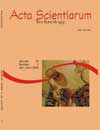Selection of categorical variables using correspondence and <em>procrustes</em> analysis
Abstract
Correspondence analysis is a technique of multivaried analysis (particularly, a method of factorial analysis to categorical variables) that allows us to obtain a graphic representation through the distribution of the scores from the categories of lines and/or columns in a system of coordinates. Krzanowski (1987) presented a methodology that combines the analysis of principal components with procrustes analysis to determine how much the new subset of variables represents the structure of the original data. The aim of this study is to propose a procedure that applies to the procrustes analysis combined with the correspondence analysis to find a rank of importance to the columns (variables) of a contingency table. That procedure has been applied according to an example by Krzanowski (1993). Some conclusions are presented about the behavior of the procedure.Downloads
Download data is not yet available.
Published
2008-05-14
How to Cite
Guedes, T. A., Ivanqui, I. L., Martins, A. B. T., & Cochia, E. B. R. (2008). Selection of categorical variables using correspondence and <em>procrustes</em> analysis. Acta Scientiarum. Technology, 21, 861-868. https://doi.org/10.4025/actascitechnol.v21i0.3084
Issue
Section
Statistics
DECLARATION OF ORIGINALITY AND COPYRIGHTS
I Declare that current article is original and has not been submitted for publication, in part or in whole, to any other national or international journal.
The copyrights belong exclusively to the authors. Published content is licensed under Creative Commons Attribution 3.0 (CC BY 3.0) guidelines, which allows sharing (copy and distribution of the material in any medium or format) and adaptation (remix, transform, and build upon the material) for any purpose, even commercially, under the terms of attribution.
Read this link for further information on how to use CC BY 3.0 properly.
0.8
2019CiteScore
36th percentile
Powered by 



0.8
2019CiteScore
36th percentile
Powered by 



















